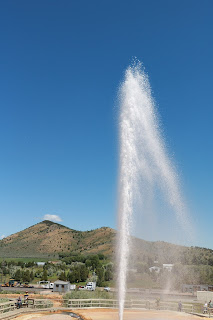Another bird bath, but a quick one since it was 38 degrees at 7 AM! Breakfast of cereal and fruit before we move on.

Pretty countryside, mostly agricultural, with lots of sheep, horses and cattle. There was a dog guarding these sheep and it took exception to our stopping so close to the flock. Lots of barking and he was headed our way when we left.

First stop is the National Oregon/California Trail Center in Montpelier. Weren't sure if it would be open, but the sign on the door said it was opening July 1st (TODAY) at 9:00, so we only had a few minutes to wait! Hand sanitizer and masks.

It was set up as though you were participants in a wagon train headed for Oregon. Texas Jeff was our Wagonmaster, dressed in western wear (and a mask).

Since we were the only customers, we received a private tour! (When we left there probably a dozen or so customers.) Jeff, who really was from Texas, was fun and informative as he explained lots of details of how a wagon train was formed and provisioned. They usually left Missouri in mid-April so that there would be food for the Oxen on the way and they would get past the high mountains before the Winter weather set in.
He showed us various weapons (He's holding a Bowie knife in the photo.) and clothing made from bear and buffalo hides.

Travelers could travel by wagon, but many if not most walked and pulled their supplies in a handcart.
 We're talking nearly 2,000 miles!
We're talking nearly 2,000 miles!Oxen were used because they were much cheaper and stronger than horses and a wagon could carry about 1500 lbs. That included supplies for 5-6 months as well as any household goods. Most provisions were dried. Each wagon usually took 3 teams of oxen and rotated them. Occasionally they had to use the oxen for food too. Chickens were often tied onto the outside of the wagon (in cages I assume :)).
The Studebaker Wagon, manufactured in Springfield, Illinois was most popular during the 1840-1869 years. (Then the railroad took over.) It was narrower than the oft pictured Conestoga wagon but sturdier. A wagon train could contain from 40-60 wagons, along with carts. The wagons were circled at night mainly to protect the livestock.
 Bathing was rare because water was a precious commodity reserved for drinking and cooking. People were encouraged to drink coffee. Though they didn't understand why, coffee cut down on illnesses like cholera because boiling the water killed bacteria.
Bathing was rare because water was a precious commodity reserved for drinking and cooking. People were encouraged to drink coffee. Though they didn't understand why, coffee cut down on illnesses like cholera because boiling the water killed bacteria.Greg and I climbed into a wheel-less wagon and it moved as though it were on a rough trail while a voice read excerpts from actual diaries of travelers.What brave and adventurous people!
The museum is built on the Clover Creek Campsite, an actual stop on the trail, and there is a campsite set up on the actual spot where wagon trains stopped, complete with dirt (sanitized) from the original site.
 Native Americans along the trail were generally friendly and helped many immigrants with food and information, in exchange for items of trade like pots and pans or jewelry. It was only when travelers stopped and tried to establish settlements that conflicts arose.
Native Americans along the trail were generally friendly and helped many immigrants with food and information, in exchange for items of trade like pots and pans or jewelry. It was only when travelers stopped and tried to establish settlements that conflicts arose.Overall, a well done stop! There were also paintings, railroad materials and information about the founding of Montpelier by Mormons.
Soda Springs was our next destination, where ,we had read, there is a geyser. Turns out it has been capped and a valve allows it to explode every hour on the hour. A few dozen people had gathered to watch.


There was also a display about the Ground Observer Corps, which we had never heard of. After WWII when there was a growing concern about the Soviet Union and a Cold War, a network of civilian Ground Observers was established to watch for low-flying enemy planes that might sneak under our radar network. By 1952 the program was called Operation Skywatch and had 750,000 volunteers at over 16,000 posts. It ended in 1958 when radar became more accurate.

We took advantage of the town of Burley to get an oil change as well as some groceries at a Safeway. This seems to be the major chain in this area. We then headed to a nearby BLM (bureau of land management) campsite on the Snake River. Passed several brilliant yellow fields of canola.
Lots of wide open space. Some of the homes are amazing in their apparent isolation. Lots of irrigation in most areas.
Nice campsite at Perch Point, with shade trees (and flowers). We did our good deed by picking up lots of trash left by others. Quite a few sites (10-15) along the river, but well separated and nearly all were occupied. We paid a whopping $2.50 at the self-serve kiosk (half price for us old farts).



That's the Snake river behind me.
Great dinner of steelhead trout and corn-on-the-cob done in the microwave.


There were several white pelicans on the river! And some beautiful grasses and flowers.
We have been in "haying" season for some time now, with fields being mowed and bales of hay stacked everywhere. Round bales, small rectangular bales, large rectangular bales and even a few hay mounds. These were along the road to our campsite. Guess all those sheep, horses and cattle have to eat!








No comments:
Post a Comment